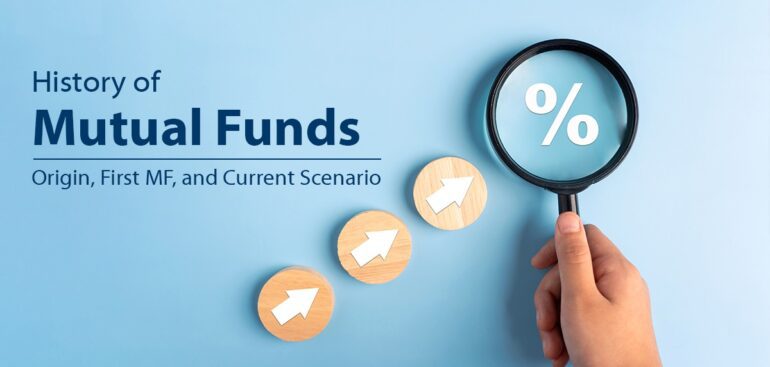India’s economy is now the fifth largest in the world, and by 2075, it wants to overtake the United States as the second largest (Source: Goldman Sachs research paper). India need substantial financial help from investors to complete this journey from the fifth to the second rank. This change will also have a significant impact on the mutual fund sector. With a manageable amount of risk, investors can increase their wealth through equity mutual funds. Let’s examine how mutual funds have developed into a prominent investing option for investor portfolios.
Mutual Fund Origin
The first investment trust was founded in London in the 1800s, and mutual funds have a long and rich history since then. But it took six decades for the first mutual fund to be introduced to the public. The Massachusetts Investors Trust (MIT), the nation’s first mutual fund, was established in 1924 and became available to investors in 1928 (Source: Investopedia).
Some funding did come in during the 1950s and 1960s, but growth was sluggish at that time. With rare exceptions, the world enjoyed phenomenal growth in the roaring ’80s and ’90s. The AUM of mutual funds in the USA increased from $5.53 lakh crore in 1998 to $22.11 lakh crore in 2022 once they acquired traction (Source: Statista).
The USA was a significant outlier in 2021, with a ratio of 140% AUM to GDP, compared to the global average of 75% (World Bank, 2021). These days, one of the most common investment options in investor portfolios is mutual funds.
History of Mutual funds in india
The mutual fund sector began in India in 1963 and has expanded rapidly ever since, particularly in the past 20 years. Let’s examine the five stages of mutual fund history.
Phase I: 1964–1987
The mutual fund sector in India began with the government’s establishment of the Unit Trust of India, which operates under the administrative and regulatory jurisdiction of the Reserve Bank of India (RBI). As a result, the Unit Scheme 1964 (US ’64), the first mutual fund scheme ever, was created, launching UTI into the mutual fund sector. Following UTI’s separation from the RBI in 1978, regulatory authority was transferred to the Industrial Development Bank of India (IDBI).
Phase 2: Public Sector MF Ingress (1987–1993)
The introduction of public sector mutual funds in 1987 was a key milestone, driven by the Public Sector banks, Life Insurance Corporation (LIC), and General Insurance Corporation (GIC). The first-ever “Non-UTI” mutual fund was created in the same year, when SBI Mutual Fund was founded. LIC followed suit, establishing its mutual fund in June 1989 and GIC’s fund in December 1990. The mutual fund AUM reached an incredible Rs 47,004 crore by the end of 1993 (Source – AMFI).
Phase 3: Private Sector MF Ingress (1993–2003)
When SEBI was founded in April 1992, the mutual fund sector saw a paradigm change. This was a critical time in protecting investor interests and supervising the expansion and regulation of the securities market. The first year that SEBI regulations were implemented for all mutual funds—UTI excluded—was 1993. A new era of mutual funds, available to a wider range of investors, began with the arrival of private sector funds. Overseas sponsors are now able to establish mutual funds in India in greater numbers. The AUM of mutual funds exceeded Rs 1.22 lakh crore by the end of January 2003 (Source: AMFI).
Phase 4: April 2014 – February 2003
After UTI was revoked in February 2003, it was divided into the UTI Mutual Fund and the Specified Undertaking of UTI (SUUTI). The fourth stage of the mutual fund industry began with the restructuring of UTI and the merging of many private-sector mutual funds. The effects of the housing bubble were also seen during this time. Furthermore, the removal of the entrance load increased the difficulties the mutual fund business faced and forced it to restructure completely over the course of the following two years. As a result, the industry grew slowly between 2010 and 2013 (Source: AMFI).
Phase 5: Present Situation (May 2014–currently)
In September 2012, SEBI implemented progressive restructuring steps in an attempt to restart the industry’s growth after the worldwide catastrophe caused by phase 4. In May 2014, the mutual fund AUM crossed Rs 10 lakh crore, and in August 2017, it crossed Rs 20 lakh crore. The AUM of the mutual fund sector as of January 31, 2024, is Rs 52.74 lakh crore, a six-fold increase over the previous ten years. As of January 31, 2024, there were 16.96 crore folios, having surpassed the 10-crore milestone in May 2021 (Source – AMFI).
This has been made possible in large part by growing public knowledge of mutual funds, the regulatory environment, and mutual fund distributors. A wider audience can now participate in mutual funds through SIP due to its ease of use, low entry hurdles (as low as Rs 100!), and convenience. In April 2016, the number of SIP accounts surpassed one crore, and as of January 31, 2024, there were 7.92 crore SIP accounts. Additionally, in the next ten years, it is anticipated that the mutual fund industry will enroll 10 crore investors and surpass an AUM of Rs 100 lakh crore (Source – AMFI).
According to AMFI and the World Bank, India’s AUM to GDP ratio is only 17%, which shows that the sector is still in its infancy and has a long way to go before reaching maturity and development. Distributors of mutual funds have been a driving force behind industry expansion and will remain crucial to it. The cooperative efforts of regulators, fund houses, and distributors will be crucial in creating a stable and investor-friendly environment as this industry navigates its transformation.


